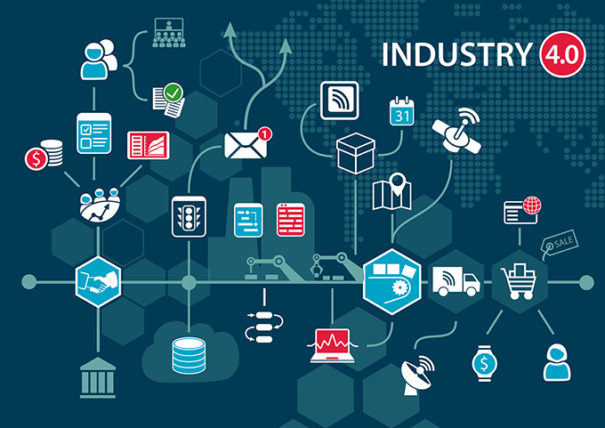Manufacturing in the era of Industry 4.0
 The topic on the Fourth Industrial Revolution has sparked discussions across various industries, and countries. A study by The Boston Consulting Group (BCG) showed that rapid adoption of Industry 4.0 could boost the country’s labour productivity by as much as 30 percent by 2024. Advancements, from smart manufacturing, robotics, to artificial intelligence and the Internet of Things (IoT), are set to power this wave of change.
The topic on the Fourth Industrial Revolution has sparked discussions across various industries, and countries. A study by The Boston Consulting Group (BCG) showed that rapid adoption of Industry 4.0 could boost the country’s labour productivity by as much as 30 percent by 2024. Advancements, from smart manufacturing, robotics, to artificial intelligence and the Internet of Things (IoT), are set to power this wave of change.
In particular, manufacturing is fundamentally changing with Industry 4.0, and the implications are far-reaching. As the International Monetary Fund (IMF) noted a broad-based yet fragile recovery in its 2017 global growth forecast, manufacturing remains a key economic driver for most countries. In Singapore, the sector accounts for 20-25% of Singapore’s Gross Domestic Product. With 99% of her registered companies being small and medium enterprises, undergoing a digital transformation as solution providers of advanced manufacturing solutions is the way forward to enhance competitiveness.
Yet today’s manufacturers face growing challenges. They need to increase capacity, reduce costs, and improve the effectiveness of their production lines and supply chains to remain competitive. Support is also needed to quickly develop connected products and ensure they can be effectively managed throughout their life cycles.
Companies can build a smart factory to improve efficiencies, reduce costs, strengthen competitiveness and create new routes to market. With the right amount of planning, it is possible for SMEs to create an IoT strategy to connect the company. Making sense of the data available and having a timely grasp on the overall situation in the factory enables companies to rapidly tune policies and processes to further enhance productivity and efficiency.
Here are some areas to address in order to progressively build a Smart Factory:
Obtaining visibility: The most common need of a factory is visibility. A manufacturer will want to know what is happening in the shop floor in near real-time, and be able to easily drill down for more details. This can be implemented via the use of an Intelligent Dashboard, where various domains of data can be summarized or displayed in various graphical formats. More specific information can be aggregated or further processed and presented in a rich graphical manner.
Maintenance of core assets: Physical core assets in a plant or factory include machines, facilities and workers. Maintenance is all about preventing faults and failures. These assets are typically required to follow a strict maintenance schedule, such as parts and consumables replacements. However as faults can be disastrous or critical to production, manufacturers can consider a predictive approach, such as making use of sensor data and machine learning to find patterns of usage that could lead to failure. Such early detection can supplement the preventive maintenance schedule to ensure a higher level of service from the core assets.
For workers, “maintenance” will be more of worker management and safety compliance. The “smart” worker management may involve the use of wearables and video analytics to monitor the performance and productivity of the worker. In terms of safety compliance, location tracking services could be deployed to monitor location of workers in permitted zones and also be able to trigger alerts if the worker’s wearable detects bad vital signs of the worker (such as heat stress, fall detection, extremely low/high heart rate, etc.). Video analytics can be used to monitor worker behaviour and dressing to ensure workers are not violating certain rules (such as smoking in non-smoking areas) and wearing suitable gears (e.g. helmets, goggles, etc.) in their area of work.
Optimizing automated processes: The next step in building a Smart Factory is to further optimize existing processes. All factories or plants use automation in their operations to a large extent. Automation could be in a closed-loop fashion, independent, or centrally coordinated. Automation can also be in the form of PLC, robots, AGV, chemical processors. While having more sensor data is unlikely to optimize these automated processes, historical data of past trends may serve as prediction for demand. Such predictive data may provide input to adjust the operations of these automated processes to meet the demand in a more optimized fashion.
A more advanced approach would be to deploy cyber-physical system (CPS) that integrates with the automation hardware or device to have a digital twin. The CPS would typically capture all data in a real-time fashion and allow control operations to be performed onto the automation hardware. The CPS could then be part of an overall management system that provides a complete autonomous control of all the systems in the factory or plant. This management system could be integrated with other sensor data input, and provide event handling capability for the overall operations of the factory or plant.
Putting Artificial Intelligence to work: The ultimate in Smart Factory would be to exploit human-like intelligence to improve factory operations. In today’s manufacturing environment, there are still stages in automation that require human intervention. This may be for quality inspection (using our eyes), traceability (using our trouble-shooting abilities), or resource optimization (using our judgement and experience in complex interactions).
Recent advances in artificial intelligence research have demonstrated human-like ability in image recognition, pattern learning, and search optimization. The technology is now ready to provide supplementary assistance to human workers. For example, instead of having human inspectors doing visual scans of a product’s surface, we can use deep learning-based image recognition software to look for defects in the initial scan. Subsequently, we can then have a secondary scan by the human inspector to confirm the defect. This will result in faster and better quality inspections.
SMEs can harness the power of Smart Factories to increase manufacturing productivity, quality and innovation at a reduced cost. The result is a highly optimized, lean manufacturing operation, where data can be acquired and analysed more quickly and effectively. As technology solution providers support companies, including SMEs, to become smart, connected and future-ready enterprises, Industry 4.0 will bring with it technology to address constraints and open up new opportunities for innovation, and truly integrate digital transformation for growth and success.

 News, training, experts opinion, bibliography, software and everything about Lean world.
News, training, experts opinion, bibliography, software and everything about Lean world.
